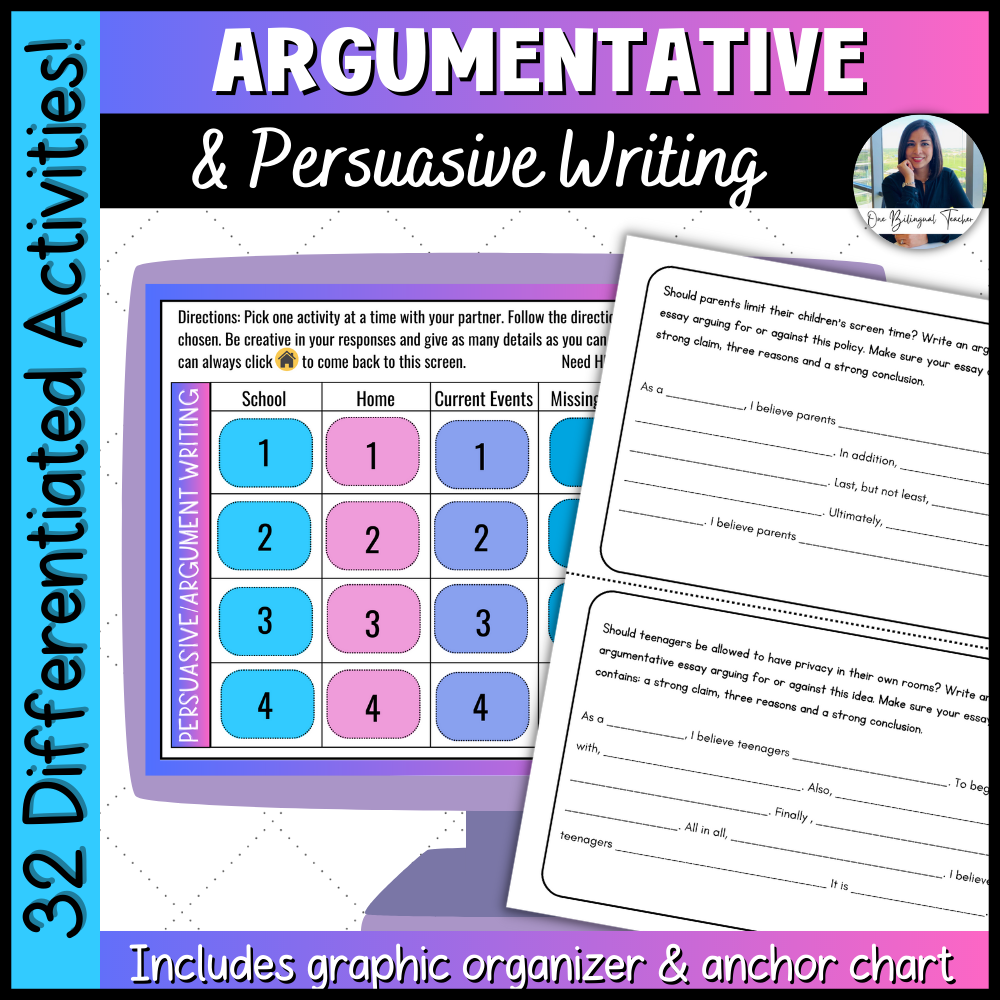Argumentative Essay Writing for ESL Middle School Students
Argumentative Essays and ESL Students
Writing argumentative essays is a must-have skill for our ESL students if we want them to succeed academically and in their future careers. That’s why we need to give them plenty of opportunities to practice writing academic essays and offer them helpful feedback.
To help them out, we should teach them how to organize their ideas and structure their essays in a way that makes sense with almost every piece of writing they complete.
Here’s a great formula that works wonders for teaching your ESL students (and everyone else) how to write an awesome argumentative essay and you can even use it for persuasive essays, opinion essays, and even expository essays!
Components of an Argumentative Essay
Background Information: When students first begin to think about their sides of the argument, they must first think about their point of view regarding the topic. Some research may need to be done to decide what their personal opinions are about the topic and what the best way to defend it is.
Introductory paragraph: The introduction grabs the reader's attention and tells them what the essay will be about. This is the most important part of a good argumentative essay. It includes a thesis statement that expresses your opinion on the topic. For example, if you're writing about whether or not schools should have uniforms, your thesis might be "School uniforms should be mandatory to promote unity and equality among students."
Body of the essay: The body paragraphs provide evidence and reasoning to support the thesis statement. Each paragraph should focus on one main point, and include evidence like quotes or statistics to back up your strong argument. For example, you might have a paragraph about how uniforms can improve academic performance and another one about how they can reduce bullying. In any case, your first sentence is super important. It opens the reader up for the reasoning behind your thesis.
Counter Arguments: Counterarguments address opposing viewpoints in the essay because you want to show that you've considered all sides of the issue. This is called a counterargument, and it's where you acknowledge the other side's opinion but then refute it with evidence that supports the argument. Strong arguments always contain a counterargument. It’s the main difference between good argumentative writing and the not-so-good.
Conclusion: The conclusion summarizes the main points and restates the thesis statement. You want to make sure you state your side of the argument once again to make it clear. It might also include a call to action or a thought-provoking statement to leave a lasting impression on your reader. For example, it could say something like "Let's make schools a better place by implementing mandatory uniform policies."
Steps to Writing an Argumentative Essay
1. Start by having your students choose a topic that they’re passionate about.
2. Have them do some research from credible and reliable sources to learn as much new information as they can about the topic.
3. Develop a thesis statement that expresses a clear argument.
4. In the body paragraphs, have them provide evidence and reasoning to support their thesis statement. Address counterarguments to make sure that their argument is as strong as possible.
5. Conclude the essay by summarizing the main points and reinforcing the thesis statement as well as the major reasons for their argument.
Choosing a Topic and Developing an Argument
Remind students to choose an interesting and relevant topic. This is important because it will help them stay motivated and keep their readers interested till the end. If they're passionate about the topic, they're more likely to write a good essay that makes a convincing argument.
Also, if they choose a topic that's relevant to their readers, they can make a real connection with them and even inspire some positive changes. Have students think about what their readers will find interesting and captivating when choosing a topic.
Examples of arguments essay prompts for middle school students:
Should students be required to wear school uniforms?
Should cell phones be allowed in the classroom?
Should junk food be banned from school cafeterias?
Should homework be abolished?
Should sports be mandatory for all students?
Should schools teach cursive handwriting?
Should students be allowed to grade their teachers?
Should schools have a later start time?
Should video games be considered a sport?
Should schools offer more vocational training programs?
Organizing and Structuring an Essay for ESL Students
Graphic organizers, mind maps, diagrams, and flowcharts can be a huge help when it comes to visualizing ideas and connecting them in a logical way. Encourage your students to get creative and try out some of these tools to see what works best for them. It might just make the writing process a little less daunting!
How to Create an Outline
Start with a clear thesis statement: The thesis statement should state the main argument or point of the essay.
Develop main points: Identify and develop the main points that support the thesis statement.
Group-related ideas: Group related ideas together and arrange them in a logical sequence.
Use topic sentences: Each paragraph should have a topic sentence that supports the main point and provides a transition to the next paragraph.
Use evidence and examples: Use evidence and examples to support each point and reinforce the thesis statement.
How to structure each paragraph
Start with a topic sentence to introduce the paragraph's main idea or point.
Use supporting sentences that provide evidence, examples, or details that support the topic sentence.
Use transition words or phrases to connect ideas and ensure coherence between paragraphs.
End with a concluding sentence that summarizes the paragraph's main point and provides a transition to the next paragraph.
Provide ESL Students with Sentence Frames
Here are a few examples:
To support my claim that [insert claim], I would like to point out that [insert evidence].
Although some may argue [insert counterargument], it is clear that [insert claim].
One piece of evidence that supports my argument is [insert evidence].
In conclusion, [restatement of thesis] and [brief summary of main points].
Writing and revising
Tips to give your ESL students for revising and editing an argumentative essay:
Take a break between writing and revising to gain a fresh perspective on the essay.
Read the essay aloud to catch errors and awkward phrasing.
Use peer editing or teacher feedback to get a second opinion on the essay.
Make sure each paragraph focuses on a single idea and has a clear topic sentence.
Check for transitions between paragraphs to ensure a smooth flow of ideas.
Here is a checklist that ESL students can use to edit and revise their argumentative essays:
Did I clearly state my thesis and main points?
Did I use evidence to support my claims?
Did I address counterarguments?
Are my paragraphs well-structured with clear topic sentences?
Did I use transitions to connect my ideas?
Did I use proper grammar, spelling, and punctuation?
Did I cite sources correctly, if necessary?
In a Nutshell
It's important to have strong writing skills, especially when it comes to writing argumentative essays. When teaching argumentative essay writing to your middle school ESL students, remember these points:
Choosing a topic that's interesting and relevant is key, and gives tips on how to structure your essay effectively.
Make sure they use evidence and good reasoning to support their argument.
To make it easier for your ESL students, have them use graphic organizers.
Need a no-prep differentiated unit on Argumentative Writing for your ESL students?
Grab these digital and print activities for your students!





